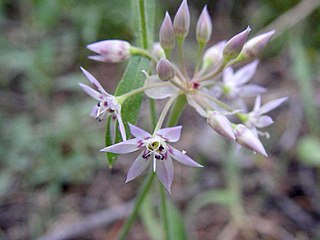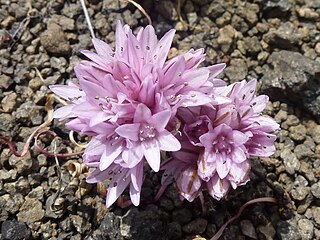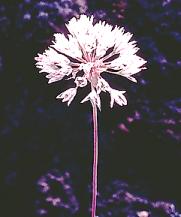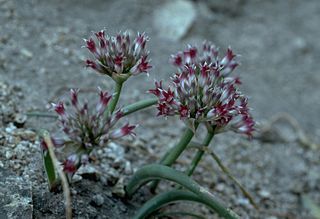
Allium validum is a species of flowering plant commonly called swamp onion, wild onion, Pacific onion, or Pacific mountain onion. It is native to the Cascade Range, to the Sierra Nevada, the Rocky Mountains, and other high-elevation regions in California, Oregon, Washington, Nevada, Idaho and British Columbia. It is a perennial herb and grows in swampy meadows at medium and high elevations.

Allium cernuum, known as nodding onion or lady's leek, is a perennial plant in the genus Allium. It grows in open areas in North America.

Allium unifolium, the one-leaf onion or American garlic, is a North American species of wild onion. It is native to the coastal mountain ranges of California, Oregon, and Baja California. It grows on clay soils including serpentine, at elevations up to 1100 m.

Allium acuminatum, also known as the tapertip onion or Hooker's onion, is a species in the genus Allium native to North America.

Allium atrorubens is a species of wild onion known by the common name dark red onion. This plant is native to the southwestern United States where it grows in the sandy soils of the Mojave Desert, the Great Basin and higher-elevation deserts in Nevada, eastern California southwestern Utah, northwestern Arizona.

Allium campanulatum is a species of wild onion known by the common name dusky onion or Sierra onion. This is a flowering plant native to the western United States from southeastern Washington and northern Oregon to southern California, and western Nevada. The dusky onion grows in foothills and mountains, especially in dry areas, such as chaparral habitats.

Allium obtusum is a species of wild onion known by the common name red Sierra onion or subalpine onion. It is native to eastern California and western Nevada. It is a common plant in the granite foothills and mountains of the Sierra Nevada and southern Cascade Range, from Tulare County to Siskiyou County, from elevations of 800 to 3,500 metres. In Nevada, it is reported only from Washoe County in the northwestern part of the state.

Allium parvum is an American species of wild onion known by the common name small onion. It is native to the western United States where it is a common member of the flora in rocky, dry areas in mountainous areas, especially in talus at elevations of 1,200–2,800 m (3,900–9,200 ft). It is widespread in California, Nevada, Oregon and Idaho, and also reported from western Utah and from extreme southwestern Montana
Allium diabolense, common name serpentine onion or devil's onion is a species of wild onion endemic to central California, where it is known from the Coast Ranges and the Transverse Ranges. It grows on serpentine soils at elevations from 500 to 1500 m, from Kern and Ventura Counties north to Stanislaus and Santa Clara Counties.

Allium jepsonii is a species of wild onion known by the common name Jepson's onion, honoring renowned California botanist Willis Linn Jepson.

Allium monticola is an uncommon species of wild onion known by the common name San Bernardino Mountain onion. It is endemic to southern California, where it is found in the Transverse Ranges and the northernmost section of the Peninsular Ranges. It has been reported from San Bernardino, Los Angeles, Orange, Ventura and Santa Barbara Counties.
Allium punctum is a species of wild onion known by the common name dotted onion or Modoc onion. It is native to the western United States in and around the Modoc Plateau in northeastern California, northwestern Nevada, and southeastern Oregon. It is uncommon, growing in volcanic flatlands created by old lava flows.
Allium dictuon is a species of wild onion known by the common name Blue Mountain onion. It is native to a small section of the Blue Mountains straddling the border between southeastern Washington and northeastern Oregon in the United States. It grows in Columbia, Garfield and Walla Walla Counties in Washington, plus Umatilla and Wallowa Counties in Oregon.

Allium aaseae, the Southern Idaho onion or Aase's onion, is a plant species endemic to southwestern Idaho. It has been reported from 6 counties: Elmore, Ada, Boise, Gem, Payette and Washington.

Allium geyeri is a North American species of onion widespread in the western United States and in western Canada. It is found in the Rocky Mountain States from New Mexico to Idaho, Great Basin, the Pacific Northwest, Texas, South Dakota, Arizona, Manitoba, British Columbia, Alberta and Saskatchewan.
Allium madidum, common name mountain swamp onion, is a plant species native to the west-central Idaho, southern Washington and eastern Oregon. It grows in wet meadows at elevations of 1100–2000 m.

Allium scilloides, called the fragile onion, is a plant species endemic to the US State of Washington. It has been reported from only 4 counties, all on the eastern side of the Cascade Range: Klickitat, Kittitas, Yakima and Grant. It grows on barren, gravelly slopes at elevations of 300–1300 m. The species is sometimes cultivated in other regions as an ornamental.

Allium tolmiei is a plant species native to Idaho, eastern and central Oregon, southeastern Washington, northwestern Nevada and northeastern California. It occurs on mountains and scrublands at elevations of 1,300–9,200 feet (400–2,800 m). It was discovered by and named for Dr. William Fraser Tolmie.

Allium douglasii, the Douglas onion, is a plant species native to northeastern Oregon, eastern Washington, and northern Idaho. It grows in shallow soils at elevations of 400–1,300 m (1,300–4,300 ft).

Allium crenulatum, common name Olympic onion, is a plant species native to Oregon, Washington, and British Columbia. It grows in the Cascades, the Coast Ranges, the Olympic Mountains, the Wenatchee Mountains, and the mountains on Vancouver Island. There is one report from Alabama, but this needs verification. The species grows on talus slopes and in alpine tundra at elevations of 600–2500 m.


















